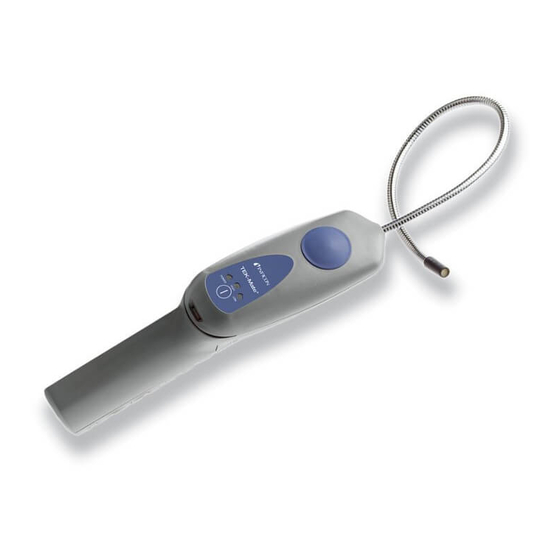
Inficon TEK-Mate Operating Manual
Refrigerant leak detector
Hide thumbs
Also See for TEK-Mate:
- Operating manual (49 pages) ,
- Quick start manual (20 pages) ,
- Operating manual (13 pages)
Table of Contents
Advertisement
Quick Links
Advertisement
Table of Contents

Subscribe to Our Youtube Channel
Summary of Contents for Inficon TEK-Mate
- Page 1 O P E R A T I N G M A N U A L ® TEK-Mate Refrigerant Leak Detector...
-
Page 3: Declaration Of Conformity
Authorized Representative . Gary W. Lewis Vice President, Quality Assurance INFICON Inc. Any questions relative to this declaration or to the safety of INFICON's products should be directed, in writing to the quality assurance department at the above address. W ARNING... -
Page 4: Table Of Contents
How to Install or Change the Sensor......5 Using Your INFICON TEK-Mate ......6 How To Find Leaks . -
Page 5: Tek-Mate's Features And Specifications
High/Low leak-sensitivity and ON/OFF in one switch. Variable-pitch audible leak signal. To get the best performance from your TEK-Mate Leak Detector, please read this manual carefully before you start using it. If you have any questions or need additional assistance, please call 800-344-3304. -
Page 6: Getting Started
When the batteries are nearing the end of their useful life, the yellow Low Battery indicator illuminates. While the batteries may operate the TEK-Mate up to a period of one hour after the Low Battery indicator illuminates, the batteries should be replaced as quickly as... -
Page 7: How To Install Or Change The Sensor
Figure 1. Properly Installed Alkaline Batteries How to Install or Change the Sensor A new TEK-Mate is shipped with its sensor packed separately. The sensor must be installed in the TEK-Mate before use. This specialized sensor will operate for about 100 hours before it will need to be replaced. -
Page 8: Using Your Inficon Tek-Mate
Be sure the edges of the cover are flat against the surface of the detector. Figure 2. Installing the Sensor Using Your INFICON TEK-Mate WARNING Do not operate this instrument in the presence of gasoline, natural gas, propane, or in other combustible atmospheres. -
Page 9: How To Change The Filter
When the instrument detects a leak source, it will emit a different audible tone. When the TEK-Mate signals a leak, pull the probe away from the leak for a moment, then bring it back to pinpoint the location. If the refrigerant leak is large, setting the sensitivity switch to LOW will make it easier to find the exact site of the leak. -
Page 10: Disposing Of The Alkaline Batteries
Troubleshooting Except for the batteries and the sensor, the internal parts of the TEK-Mate Leak Detector are not user serviceable. If you experience a problem with your TEK-Mate, see the Troubleshooting Table below to determine how to remedy the problem. If you can not remedy the problem, take your TEK-Mate to your wholesaler for warranty evaluation. -
Page 11: Return Authorization Procedure
Return Authorization Procedure All defective TEK-Mates, or defective replacement parts and accessories, should be returned to your wholesaler for warranty evaluation. If you have any questions, please contact INFICON at 800-344-3304. NOTE: Do not return you defective unit directly to the factory... -
Page 12: Replacement Parts And Accessories
fitness for a particular purpose or otherwise. All such other warranties are expressly disclaimed. INFICON shall have no liability in excess of the price paid to INFICON for the instrument plus return transportation charges prepaid. INFICON shall have no liability for any incidental or consequential damages. -
Page 13: Special Information For Automotive Technicians
Special Information For Automotive Technicians INFICON's TEK-Mate Refrigerant Leak Detector Model #705-202-G1 is design certified by MET Laboratories, Inc. to meet SAE J1627, “Rating Criteria for Electronic Refrigerant Leak Detectors” for R12, R22, and R134a. The following SAE Recommended Practice applies... - Page 14 Always follow the refrigerant system around in a continuous path so that no areas of potential leaks are missed. If a leak is found, always continue to test the remainder of the system. At each area checked, the probe shall be moved around the location, at a rate no more than 1 to 2 inches/second (25 to 50 mm/second) and no more than 1/4 inch (5 mm) from the surface completely around the position.
- Page 16 T W O T E C H N O L O G Y P L A C E E A S T S Y R A C U S E , N Y 1 3 0 5 7 - 9 7 1 4 U S A Phone: +315.434.1100 Fax: +315.437.3803 Email: reachus@inficon.com www.inficon.com 074-336-P1B...

Need help?
Do you have a question about the TEK-Mate and is the answer not in the manual?
Questions and answers